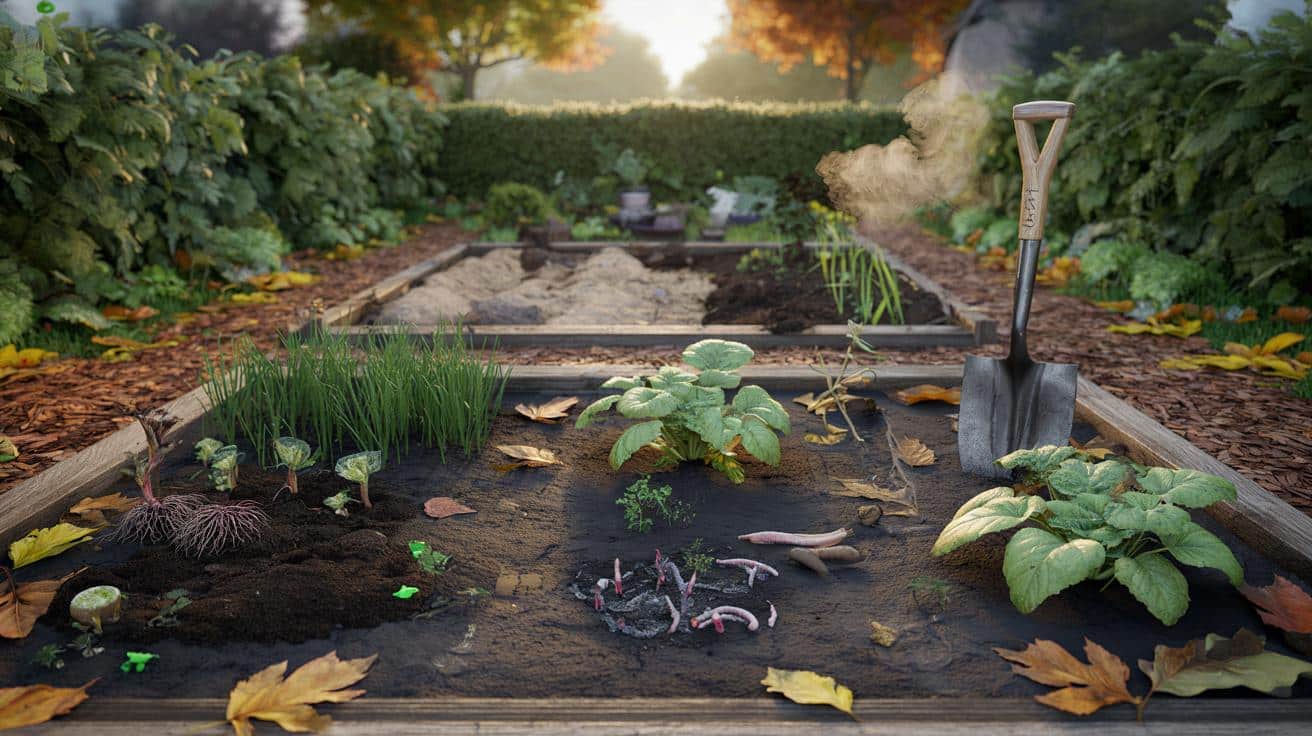There’s a small temptation tugging at gardeners every autumn: the neatness of a freshly turned bed. Spade over shoulder, you can almost hear the soil sigh. And yet the fastest way to slow your garden next spring is to flip it all now. Resist the churn. Let the ground keep its quiet order.
The steam rose like breath from a horse. You could smell that sweet, earthy note that makes you feel you’ve done a proper day’s work even before breakfast. We chatted about beans and blight and the quiet winter ahead, and still my eyes kept dropping to the dark slabs he’d lifted.
Across the path, my beds lay flat, mulched and still. Worm casts dotted the surface like punctuation marks. No drama, no clods, just a thick duvet of compost and leaves waiting for frost. It looked almost lazy. It wasn’t. It was deliberate.
I headed home with cold fingers and a thought I couldn’t shake. Don’t dig.
Why turning your soil now will cost you in spring
When you flip your beds in autumn, you fracture the underground city that’s been building all year. Fungal threads snap, worm tunnels collapse, and the delicate crumbs that hold air and moisture get smashed into plates. Soil life doesn’t just “bounce back” because you want it to. It rebuilds on its own timeline, not yours.
There’s a second, sneakier hit. Buried weed seeds wake up when you roll them into the light, setting you up for a green confetti explosion the moment temperatures rise. That neat October ridge becomes April’s weeding marathon. Charles Dowding’s trials on no‑dig beds show fewer weeds and better moisture retention simply by leaving the soil undisturbed and feeding from above.
There’s also the matter of carbon. Every turn releases a puff of stored soil carbon into the air, and winter rain washes away structure you’ve just broken. Bare, flipped ground sheds nutrients, silts paths, and leaves you with a crust that repels spring showers. Leave it intact and you hold the good stuff where roots can find it. That’s not romance. That’s physics and biology shaking hands.
What to do instead: the easy autumn no‑dig routine
Think blanket, not blender. Clear spent crops by cutting stems at the base, leaving roots to rot quietly as food for microbes and channels for air. Spread 3–5 cm of mature compost over the surface, edge to edge, like icing a cake. Add a layer of chopped leaves if you have them, and let the worms do the heavy lifting. This is the season to step back.
Worried about slugs under mulch? Keep edges tidy, lift boards and pots, and mix in something twiggy so it’s not a slug hotel. If your soil is heavy clay, lay down a lighter, fibrous top like leaf mould to keep it breathing. Sow a quick green manure in any bare patch you’ll leave past November. **No‑dig** isn’t passive. It’s just quiet work that compounds.
Let’s be honest: nobody really does that every day. You don’t need to. A few crisp hours now sets you up for months.
“Soil isn’t empty space to be controlled. It’s a living fabric that grows stronger when you stop picking at the threads.”
- Quick swap: Pulling vs. cutting — cut at the base to keep roots in place.
- Mulch depth: 3–5 cm compost, then a light leaf layer if you’ve got the stash.
- Green manures to try: **Field beans**, **phacelia**, or crimson clover before hard frosts.
- Paths matter: Lay woodchip on paths to feed fungi and keep your boots off wet beds.
- Check once a month: Lift mulch to peek for slug clusters and egg sacs, then tuck it back.
A gentler winter, a stronger garden
We’ve all had that moment when you glance out at your plot and feel a twinge of guilt because it looks too calm. Autumn can play tricks like that. The work is still happening, just under your feet. Worms pull down leaves. Fungi stitch together new alliances. Moisture settles in, not off, and your spring roots will follow those quiet tracks.
Skipping the flip also buys you time. Instead of heaving clods, sort seeds, fix a wobbly fence, clean tools, and brew a small compost heap from trimmings. Care doesn’t always look busy. The garden doesn’t grade you on effort, it responds to rhythm. And right now, the rhythm favours cover, patience, and a lighter touch.
When neighbours are sharpening spades, it can feel rebellious to lean on a rake and simply top‑dress. Still, the beds you leave undisturbed in October tend to be the ones you harvest sooner in April. The soil holds its shape. Water soaks where it lands. Weeds show up, sure, but far fewer. That quiet head start is real.
Look at it this way: autumn is your one chance to set the table without stirring the soup. Let roots remain as scaffold, lay a soft cap of compost, and plant the odd green manure if the window’s still open. The birds will ruffle the leaves. The fox will tip the watering can. Life goes on, richness piles up, and you’ve done the thing that matters most by not doing the thing that looks busy. Share this with the friend who loves a tidy edge. Ask them to try one bed your way. The proof, come spring, is not subtle.
| Point clé | Détail | Intérêt pour le lecteur |
|---|---|---|
| Preserve structure | Leave aggregates, worm burrows, and fungal networks intact | Faster spring growth and better drainage without extra work |
| Reduce weeds | Don’t bring dormant seeds to the surface; smother with mulch | Less time weeding, more time sowing and harvesting |
| Hold carbon and moisture | Skip flipping that vents carbon; cap with compost to keep water in | Healthier soil and steadier watering needs across dry spells |
FAQ :
- Won’t slugs explode under mulch?Mulch can shelter slugs, yet a loose, airy layer with mixed textures is less inviting. Keep edges clean, lift hiding spots, and encourage predators. Tidy at a human pace, not daily sprints.
- What if my soil is heavy clay?Clay thrives under **no‑dig**. Add thin compost caps each autumn, avoid walking on wet beds, and let freeze‑thaw and roots open it. Field beans and phacelia are great winter helpers.
- Can I still plant garlic and broad beans?Yes. Mulch first, then part the surface with a trowel and drop cloves or beans into firm soil beneath. They root into the stable layer and sit snug through cold snaps.
- Is it ever right to dig?Spot digging to remove bindweed roots or lift deep compaction once is fair. Think surgery, not routine. Then return to top‑dressing and let biology keep the gains.
- Am I too late for green manures?If frosts are looming, go for winter‑hardy choices like field beans or rye. If the window’s shut, skip sowing and mulch instead. The cover matters more than the species badge.










Tempted to try this—no spade, no guilt!